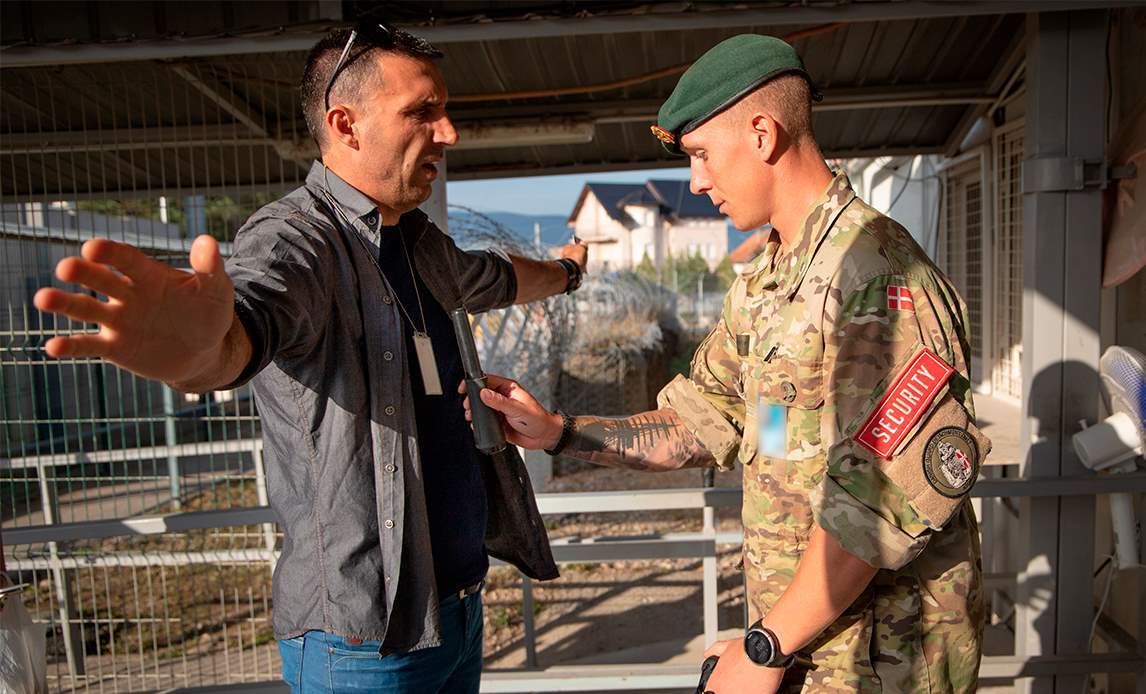Kosovo - peace efforts since 1999
Danish soldiers have supported the international effort for peace in Kosovo since 1999 in the NATO-led operation KFOR.

Danish soldiers guard the French Camp Marechal De Lattre de Tassigny and perform, among other things, access control. Photo: Lærke Weensgaard Madsen / The Danish Armed Forces
The Kosovo mission began in the autumn of 1999, when 875 Danish soldiers as part of the NATO-led Kosovo Force (KFOR) were stationed in the conflict-ridden area. Kosovo was then part of the now former Yugoslavia. KFOR numbered about 50,000 soldiers when the mission was at its peak in early 2000.
The Danish contribution was 875 soldiers when it was largest, and KFOR was for a period the Army's largest international mission. As the Army's international involvement expanded elsewhere and the security situation in Kosovo improved, the Army's contribution to KFOR was reduced.
The main task for the currently approximately 35 Danish soldiers in the Kosovo Force (KFOR) is guarding Camp Marechal De Lattre de Tassigny at Novo Selo. The Danish soldiers also solve tasks at KFOR's headquarters in Pristina. From August 2023 and two years on the guarding task i Kosovo is handled by the Danish National Home Guard.
Important events during the Danish effort
Denmark's contribution to the NATO mission in Kosovo has extended over many years. Here are some of the most notable events:
- June 10, 1999. NATO concludes a military technical agreement with Yugoslavia, ensuring that Serbian military and police units withdraw from Kosovo and that the NATO force Kosovo Force (KFOR) can withdraw. On June 12, the first NATO troops enter Kosovo.
- August 1999: The first team of 875 Danish soldiers at KFOR settles in the two camps Camp Olaf Rye and Camp Holger Danske.
- February 2001. At the transition between KFOR teams 3 and 4, the Danish battalion Camp Holger Danske closes, so the entire Danish contribution is gathered in Camp Olaf Rye two kilometers from Mitrovica.
- March 2004. Two Kosovo Albanian boys drown in the Ibar River and a false rumour that Kosovo Serbs have driven them into the river sets 17-18. March time in violent unrest. Large parts of the Danish battalion, which at this time has 350 soldiers (KFOR team 10), must move into Mitrovica to keep Kosovo Albanians and Kosovo Serbs separate. In the days around 20 March, 96 additional soldiers from Denmark arrive to reinforce the Danish battalion in Kosovo. Within a week, the unrest stops, but the Danish government shelves all plans for further reductions of KFOR.
- February 17, 2008: Kosovo declares independence. The decision is, as one might expect, very unpopular among the Kosovo Serbs, who are a large population group in the Danish area of responsibility, where KFOR team 18 has just arrived. The Danes set up check points and patrol frequently. During March, there are various protests. Among other things, Kosovo Serbs burn a border post and occupy a courthouse in Mitrovica.
- January 2010: The Danish battalion closes Camp Olaf Rye and moves to the French camp in Novo Selo. The force, of which the Danes are a part, changes its name from Multinational Task Force North (MNTF-N) to Multinational Battlegroup North (MNBG-N). At the same time, the Danish force will be reduced in February 2010 from 350 men (KFOR team 21) to 180 men (KFOR team 22).
- February 2011: The Home Guard takes over the task in Kosovo from the Army. At the same time, the Danish contribution from KFOR's team 23 of 180 men is reduced to a guard division of approx. 30 men based in the camp in Novo Selo as well as a small staff contribution of five officers at KFOR's headquarters in Pristina (KFOR team 24). The main reason why the Home Guard is given the task is that the Army during this period spends a lot of energy and resources on the task in Afghanistan.
- August 2013: The army takes on the task of providing guard division to KFOR back from the Home Guard. The size of the contribution is the same. The change takes place during the transition from KFOR team 27 (Home Guard) to KFOR team 28 (Army) and takes place because the Army's other international tasks now have a smaller scope than in 2011, when the Home Guard joined and relieved the Army in Kosovo.
- August 2023: The Army hands over the task of providing guard division to KFOR to the Home Guard. The size of the contribution is the same.
-
Place
Kosovo -
Operation strength
NATO -
Period of time
Fra 1999 -
Current
Yes